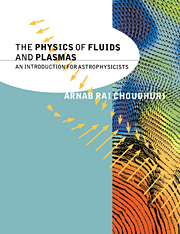Book contents
- Frontmatter
- Contents
- Preface
- Acknowledgements
- Introduction
- Part I Neutral fluids
- Part 2 Plasmas
- 10 Plasma orbit theory
- 11 Dynamics of many charged particles
- 12 Collisionless processes in plasmas
- 13 Collisional processes and the one-fluid model
- 14 Basic magnetohydrodynamics
- 15 Theory of magnetic topologies
- 16 Dynamo theory
- Epilogue
- Appendix A Useful vector relations
- Appendix B Integrals in kinetic theory
- Appendix C Formulae and equations in cylindrical and spherical coordinates
- Appendix D Values of various quantities
- Appendix E Basic parameters pertaining to plasmas
- Suggestions for further reading
- References
- Index
10 - Plasma orbit theory
from Part 2 - Plasmas
Published online by Cambridge University Press: 05 June 2012
- Frontmatter
- Contents
- Preface
- Acknowledgements
- Introduction
- Part I Neutral fluids
- Part 2 Plasmas
- 10 Plasma orbit theory
- 11 Dynamics of many charged particles
- 12 Collisionless processes in plasmas
- 13 Collisional processes and the one-fluid model
- 14 Basic magnetohydrodynamics
- 15 Theory of magnetic topologies
- 16 Dynamo theory
- Epilogue
- Appendix A Useful vector relations
- Appendix B Integrals in kinetic theory
- Appendix C Formulae and equations in cylindrical and spherical coordinates
- Appendix D Values of various quantities
- Appendix E Basic parameters pertaining to plasmas
- Suggestions for further reading
- References
- Index
Summary
Introductory remarks
We now begin the study of plasmas, which are gases in which the constituent particles are charged. In a gas made up of neutral particles, two particles are assumed to interact only when they collide, i.e. are physically very close. Between collisions, the neutral particles move along straight lines. In contrast, the particles in a plasma always interact with each other through long-range electromagnetic interactions and the trajectories of individual particles can be quite complicated. Before investigating how collections of charged particles behave, it is worthwhile developing some ideas about the motions of individual charged particles in electromagnetic fields. This topic is referred as the plasma orbit theory and often turns out to be very useful in handling problems involving plasmas. While developing the theory of neutral gases in Chapters 2–3, it was not necessary to pay much attention to motions of individual neutral particles, as these motions are quite simple. After discussing motions of individual plasma particles in this chapter, we shall, however, follow a course of development roughly similar to that which we followed for neutral fluids. In the next chapter, we shall begin developing theoretical techniques for treating plasmas as collections of charged particles and eventually we shall end up with continuum models in Chapters 14–16.
As soon as we start discussing electromagnetic quantities, we face the vexing question of choosing units.
Information
- Type
- Chapter
- Information
- The Physics of Fluids and PlasmasAn Introduction for Astrophysicists, pp. 197 - 215Publisher: Cambridge University PressPrint publication year: 1998
